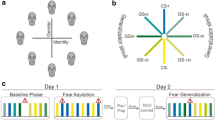Abstract
Rhesus monkeys(Macaca mulatto) were tested in classic aversive and appetitive conditioning paradigms following complete coronary artery occlusion (CO) to test the hypothesis that “emotional stress” induces ventricular arrhythmias. Findings were based upon conditioning trials conducted for one or more weeks after occlusion in 13 animals. When all data from each animal for the week following CO were considered, there was no demonstrable tendency for arrhythmias to increase during “fear” conditioned to unavoidable electric shock or during “excitement” in anticipation of food. However, selected trials from six monkeys did reveal instances when changes in the frequency of occurrence of arrhythmias were coupled with behavioral conditioning. While analysis of these trials did not reveal any simple relationship between emotional stress and the development of ventricular arrhythmias after myocardial infarction, certain of the behavioral situations may be more potentially arrhythmogenic than others. For these selected trials, with respect to control, the number of arrhythmias may have increased or decreased upon presentation of the conditional stimulus; the exact response appears to depend upon the immediate physiologic status of the animal as well as on the behavioral condition. “More stressful” situations, such as aversive conditioning, are not necessarily associated with greater numbers of arrhythmias than were “less stressful” situations, such as appetitive conditioning. Arrhythmias appear to occur more frequently when an animal’s heart rate is within a given range; this may reflect underlying cardiac sympathetic and parasympathetic nerve activity.
Similar content being viewed by others
References
Armour, J. A., Hageman, G. R., and Randall, W. C.: Arrhythmias induced by local cardiac nerve stimulation.American Journal of Physiology, 223, 1068–1075, 1972.
Billman, G. E., Hasson, D. M., and Randall, D. C.: Acquisition and discrimination of appetitively and aversively conditioned heart rate responses in rhesus monkeys.Pavlovian Journal of Biological Science, 13, 145–150, 1978.
Cobb, L. A., Werner, J. A., and Trobaugh, G. B.: Sudden cardiac death I. A decade’s experience with out-of-hospital resuscitation.Modern Concepts of Cardiovascular Disease, 49, 31–36, 1980.
Corbalan, R., Verrier, R., and Lown, B.: Psychological stress and ventricular arrhythmias during myocardial infarction in the conscious dog.American Journal of Cardiology, 34, 692–696, 1974.
D’Agrosa, L. S.: Cardiac arrhythmias of sympathetic origin in the dog.American Journal of Physiology, 233, H535-H540, 1977.
Dimsdale, J. E.: Emotional causes of sudden death.American Journal of Psychiatry, 134, 1361–1366, 1977.
El-Sherif, N., Scherlag, B. J., Lazzara, R., and Hope, R. R.: Re-entrant ventricular arrhythmias in the late myocardial infarction period. 1. Conduction characteristics in the infarction zone.Circulation, 55, 686–702, 1977.
Engel, G. L.: Sudden and rapid death during psychological stress—folklore or folk wisdom.Annals of Internal Medicine, 74, 771–782, 1971.
Hackel, D. B., and Ratliff, N. B., Jr.: A technic to estimate the quantity of infarcted myocardium post mortem.American Journal of Clinical Pathology, 61, 242–246, 1974.
Hageman, G. K., Goldberg, J. M., Armour, J. A., and Randall, W. C.: Cardiac dysrhythmias induced by autonomic nerve stimulation.American Journal of Cardiology, 32, 823–830, 1973.
Lown, B., DeSilva, R. A., and Lenson, R.: Roles of psychologic stress and autonomic nervous system changes in provocation of ventricular premature complexes.American Journal of Cardiology, 41, 979–985, 1978.
Lynch, J. J., Paskewitz, D. A., Gimbel, K. S., and Thomas, S. A.: Psychological aspects of cardiac arrhythmia.American Heart Journal, 93, 645–657. 1977.
Matta, R. J., Lawler, J. E., and Lown, B.: Ventricular electrical instability in the conscious dog.American Journal of Cardiology, 38, 594–598, 1976.
Mills, M. E., Thomas, S. A., Lynch, J. J., and Katcher, A. H.: Effect of pulse palpation on cardiac arrhythmia in coronary care patients.Nursing Research, 25, 378–382, 1976.
Nathan, M. A., and Smith, O. A., Jr.: Differential conditional emotional and cardiovascular responses—a training technique for monkeys.Journal of the Experimental Analysis of Behavior, 11, 77–82, 1968.
Pickering, T. G., and Miller, N. E.: Learned voluntary control of heart rate and rhythm in two subjects with premature ventricular contractions.British Heart Journal, 49, 152–159, 1977.
Randall, D. C.: Concurrent measurement of left ventricular dP/dtmax, isometric contractile force and cardiac loading in intact monkey.Cardiology, 59, 304–318, 1974.
Randall, D. C., Brady, J. V., and Martin, K. H.: Cardiovascular dynamics during classical appetitive and aversive conditioning in laboratory primates.Pavlovian Journal of Biological Science, 10, 66–75, 1975.
Randall, D. C., Kaye, M. P., Randall, W. C., Brady, J. V., and Martin, K. H.: Response of primate heart to emotional stress before and after cardiac denervation.American Journal of Physiology, 230, 988–995, 1976.
Randall, D. C., Hasson, D. M., and Brady, J. V.: Acute cardiovascular consequences of anterior descending coronary artery occlusion in unanesthetized monkey.Proceedings of the Society for Experimental Biology and Medicine, 58, 135–140, 1978.
Randall, D. C., Hasson, D. M., and Brady, J. V.: Conditional cardiovascular response to shock before and after coronary arterial occlusion.American Journal of Physiology, 236, H273-H279, 1979.
Rosenfeld, J., Rosen, M. R., and Hoffman, B. F.: Pharmacologie and behavioral effects on arrhythmias that immediately follow abrupt coronary occlusion: a canine model of sudden coronary death.American Journal of Cardiology, 41, 1075–1082, 1978.
Skinner, J. E., Lie, J. T., and Entman, M. L.: Modification of ventricular fibrillation latency following coronary artery occlusion in the conscious pig.Circulation, 51, 656–667, 1975.
Strauss, H. W., Harrison, K., Langan, J. K., Lebowitz, E., and Pitt, B.: Thallium-201 for myocardial imaging.Circulation, 51, 641–645, 1975.
Author information
Authors and Affiliations
Additional information
A preliminary report of these findings has been published in P. J. Schwartzet al. (Eds.),Neural Mechanisms in Cardiac Arrhythmias, New York: Raven Press, 1978, pp. 279–282, and in S. S. Kalter (Ed.),The Use of Nonhuman Primates in Cardiovascular Disease, Austin, Texas: University of Texas Press, 1980, pp. 253–255.
Supported by NIH grant HL 19343.
Rights and permissions
About this article
Cite this article
Randall, D.C., Hasson, D.M. Cardiac arrhythmias in the monkey during classically conditioned fear and excitement. Pav. J. Biol. Sci. 16, 97–107 (1981). https://doi.org/10.1007/BF03001851
Issue Date:
DOI: https://doi.org/10.1007/BF03001851



